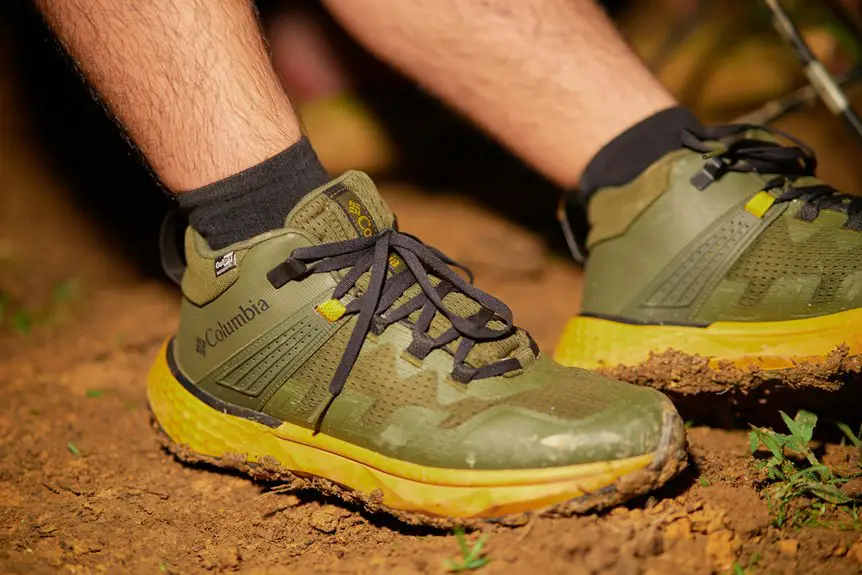When your Gore-Tex “wets out,” the outer fabric has stopped repelling water and becomes saturated, making your gear feel clammy and heavy even though the membrane inside remains waterproof. This happens during prolonged rain or heavy sweating when the Durable Water Repellent (DWR) coating wears off, allowing water to soak in. Moisture then clings to the fabric surface, reducing breathability and comfort. If you want to understand why this happens and how to prevent it, keep exploring the details.
Table of Contents
Key Takeaways
- “Wets out” means the outer Gore-Tex fabric becomes saturated, losing its water-repellent ability and feeling clammy or heavy.
- It occurs when the Durable Water Repellent (DWR) coating wears off, allowing water to soak into the outer layer.
- Heavy rain, prolonged wet conditions, or high sweat levels can overwhelm the membrane, causing the fabric to wet out.
- Wetting out results in water droplets spreading on the surface instead of beading and can cause internal dampness despite no leaks.
- Proper care, cleaning, and DWR reapplication help prevent wetting out and maintain Gore-Tex’s waterproof breathability.
How Gore-Tex Technology Works
Although it might seem complex, Gore-Tex technology works by combining a breathable membrane with durable outer layers to keep you dry.
When you wear Gore-Tex gear, the membrane acts as a barrier that blocks liquid water from entering while allowing water vapor, like sweat, to escape. This means you stay dry from rain but won’t feel clammy inside.
The outer fabric protects the membrane from damage and dirt, ensuring it works effectively over time. You’ll notice how Gore-Tex garments feel lightweight yet tough, designed for both comfort and performance.
The durable outer fabric shields the membrane, keeping Gore-Tex gear lightweight, tough, and built for lasting comfort and performance.
This clever layering means you can trust your gear in wet conditions without sacrificing breathability or mobility, helping you stay comfortable during outdoor adventures.
The Science Behind Gore-Tex Membranes
You’ll want to understand how Gore-Tex membranes are structured to see why they’re both waterproof and breathable.
It’s all about how moisture vapor moves through the tiny pores without letting liquid water in.
Let’s break down what makes this balance possible and why it matters for staying dry.
Membrane Structure Explained
Understanding the membrane structure is key to grasping how Gore-Tex keeps you dry while letting sweat escape. The membrane is made of expanded polytetrafluoroethylene (ePTFE), which has billions of microscopic pores per square inch.
These pores are tiny enough to block liquid water droplets but large enough to allow water vapor molecules from your sweat to pass through. This unique structure creates a physical barrier against rain and snow while maintaining breathability.
When you wear Gore-Tex, your body heat causes sweat to vaporize. The vapor moves through the membrane’s pores and escapes, preventing moisture buildup inside.
At the same time, external water can’t penetrate because the pores repel liquid water. This balance between waterproofing and breathability comes directly from the membrane’s precise microscopic architecture.
Waterproof vs. Breathable
The membrane’s microscopic pores don’t just block water—they create a delicate balance between keeping you dry and allowing sweat to escape. Gore-Tex membranes are engineered to be both waterproof and breathable, but understanding the difference helps you appreciate their performance. Waterproof means rain and external water can’t penetrate, while breathable means sweat vapor can leave your clothing, preventing discomfort. Here’s a quick comparison:
| Feature | Waterproof | Breathable |
|---|---|---|
| Purpose | Blocks liquid water | Allows moisture vapor out |
| Benefit | Keeps you dry in rain | Prevents sweat buildup |
| Mechanism | Tiny pores smaller than water droplets | Pores larger than water vapor molecules |
| Result | No water penetration | Comfort during activity |
This balance is what makes Gore-Tex effective in harsh weather.
Moisture Vapor Dynamics
Gore-Tex membranes work by managing moisture vapor through a network of microscopic pores that are carefully sized to let sweat escape while blocking liquid water.
When you’re active, your body produces sweat, which turns into vapor. This vapor passes through the membrane’s pores, keeping you dry inside. However, this process depends on temperature and humidity differences between the inside and outside of your garment.
To understand the moisture vapor dynamics, keep these points in mind:
- Microscopic pores are about 20,000 times smaller than a water droplet
- Pores allow vapor molecules to escape but block liquid water
- Vapor transport relies on a vapor pressure gradient
- High external humidity or temperature can reduce breathability
This balance is key to preventing your gear from feeling wet inside.
Causes of Gore-Tex Wets Out
Although Gore-Tex is designed to keep you dry, certain conditions can cause it to “wet out,” meaning the outer fabric becomes saturated with water. This usually happens when the outer layer is exposed to heavy, prolonged rain or snow, overwhelming its water-repellent coating.
If the Durable Water Repellent (DWR) treatment wears off from frequent use or washing, water will soak into the fabric instead of beading and rolling off. Additionally, if you’re active and generate a lot of sweat, moisture may build up inside, increasing the chances of wetting out.
Environmental factors like high humidity and cold temperatures can also reduce breathability, causing condensation on the fabric’s surface. Taking care of your Gore-Tex gear and reapplying DWR helps prevent this issue.
Signs Your Gore-Tex Gear Is Wets Out
You’ll know your gear is wetting out when the outer fabric stops repelling water and feels clammy or heavy. Instead of beading off, water soaks into the surface, making it look darker and damp.
You’ll notice your jacket or pants lose their usual lightness, and the fabric might stick to your skin uncomfortably.
Watch for these signs:
- Water droplets no longer bounce off but spread across the fabric.
- The garment feels heavier, especially after rain or snow.
- The outer layer looks visibly darker or saturated.
- Condensation forms inside, making the interior damp despite no leaks.
Recognizing these signs early helps you take action before your gear’s performance drops further.
How Moisture Affects Breathability
When moisture builds up inside your Gore-Tex gear, it can reduce how well the fabric breathes.
You’ll notice that sweat and humidity struggle to escape, making you feel clammy.
Understanding how wet conditions change fabric performance helps you manage comfort better.
Moisture Impact on Breathability
Since moisture plays an essential role in how well Gore-Tex garments breathe, understanding its effects can help you manage comfort better.
When moisture accumulates inside your jacket, it can reduce breathability by blocking the membrane’s tiny pores. This leads to a buildup of sweat and heat, making you feel clammy.
You’ll notice breathability decreases as the moisture level rises, especially during high-intensity activities. To keep your Gore-Tex performing effectively, consider these factors:
- Excess internal moisture slows vapor transfer.
- External wetness can cause slight pore blockage.
- Adequate ventilation helps moisture escape.
- Layering choices influence moisture buildup.
Fabric Performance When Wet
Although Gore-Tex fabrics are designed to repel water, their breathability can still suffer when the outer layer gets soaked. When moisture clings to the fabric surface, it blocks air exchange, making it harder for sweat vapor to escape. This “wetting out” effect can leave you feeling clammy despite the fabric’s waterproof claim. Understanding how moisture impacts performance helps you manage your gear better.
| Condition | Breathability Impact |
|---|---|
| Dry | Ideal, maximum airflow |
| Light moisture | Slightly reduced airflow |
| Saturated outer layer | Notably reduced airflow |
| Heavy sweating | Increased internal humidity |
| Drying period | Breathability gradually restores |
Keep your Gore-Tex dry outside to maintain comfort and function.
Common Situations When Gore-Tex Wets Out
Why does Gore-Tex sometimes feel wet on the inside even though it’s designed to keep you dry? This usually happens when moisture from your body gets trapped inside or when the outer layer becomes saturated, preventing proper breathability.
You might notice this in several common situations:
- Intense physical activity causing heavy sweating
- Wearing multiple layers that block moisture escape
- Staying in rainy conditions for extended periods
- Using a jacket with clogged or dirty membranes
In these cases, the Gore-Tex membrane struggles to move moisture out efficiently, making your gear feel damp inside.
Understanding these scenarios helps you recognize why “wets out” happens, even with high-performance fabrics designed to keep you dry and comfortable.
Preventing Gore-Tex From Wets Out
To keep your Gore-Tex gear from feeling wet inside, you need to manage moisture and airflow effectively.
Start by wearing moisture-wicking base layers to pull sweat away from your skin and reduce internal dampness. Avoid overdressing, as excess sweat can saturate your clothing.
When possible, unzip vents or loosen layers to increase airflow and help moisture escape. Pay attention to your activity level and the weather to adjust your layering accordingly.
Also, try to avoid prolonged exposure to heavy rain without breaks, as continuous external moisture can overwhelm the membrane.
Care and Maintenance Tips for Gore-Tex
To keep your Gore-Tex gear performing well, you need to clean it properly, restore its water repellency, and store it correctly.
Skipping these steps can cause your fabric to lose breathability and waterproofing.
Let’s go over simple ways to maintain your Gore-Tex so it lasts longer and stays effective.
Cleaning Gore-Tex Fabrics
Proper cleaning is essential for maintaining your Gore-Tex fabric’s waterproof performance and breathability. When you clean your gear, you remove dirt, oils, and residues that can clog the membrane and reduce its effectiveness.
To clean Gore-Tex properly, follow these tips:
- Use a gentle detergent free of fabric softeners and bleach
- Wash in warm water on a gentle cycle or hand wash if preferred
- Rinse thoroughly to remove all soap residues
- Avoid fabric softeners, stain removers, and harsh chemicals
After washing, air dry or tumble dry on low heat to help maintain the fabric’s structure.
Restoring Water Repellency
Although regular cleaning keeps your Gore-Tex fabric performing well, its durable water repellent (DWR) coating can wear off over time, causing water to soak in rather than bead up.
To restore water repellency, apply a spray-on or wash-in DWR treatment designed specifically for Gore-Tex or similar fabrics. Before applying, make sure your garment is clean and damp, as this helps the treatment absorb evenly.
Follow the product instructions carefully, and after application, heat-activate the DWR by tumble-drying on low or using a warm iron with a cloth barrier. This step seals the coating and improves water beading.
Restoring water repellency regularly keeps your gear dry and extends its lifespan, so don’t skip this simple maintenance to keep performing at its best.
Proper Storage Techniques
When you’re not using your Gore-Tex gear, how you store it plays a big role in maintaining its performance. Proper storage helps prevent damage, keeps the fabric breathable, and preserves the Durable Water Repellent (DWR) coating.
You want to avoid conditions that promote mildew or fabric breakdown.
Follow these tips for storing your Gore-Tex gear:
- Store it clean and completely dry to prevent mold and odor.
- Keep it loosely folded or hung in a cool, dry place away from direct sunlight.
- Avoid compressing it tightly for long periods, which can damage membranes and coatings.
- Don’t store it near chemicals or heat sources that can degrade the fabric.
Comparing Gore-Tex to Other Waterproof Fabrics
Since waterproof fabrics vary widely in technology and performance, understanding how Gore-Tex stacks up against others can help you choose the best option for your needs.
Gore-Tex uses a membrane with microscopic pores that block water droplets but let moisture vapor escape, offering reliable waterproofing and breathability. Compared to materials like polyurethane-coated nylon or PVC, Gore-Tex generally breathes better, reducing sweat buildup during activity.
Gore-Tex’s microporous membrane blocks water but allows moisture vapor out, enhancing waterproofing and breathability.
However, some newer fabrics, like eVent or NeoShell, claim to offer comparable or improved breathability. If you prioritize lightweight and affordable gear, other waterproof fabrics might suit you better, though they often sacrifice breathability or durability.
Gore-Tex balances protection and comfort, but knowing your activity level and environment will guide you toward the fabric that fits your demands.
When to Replace Your Gore-Tex Gear
How do you know it’s time to replace your Gore-Tex gear? If your jacket or pants no longer keep water out or feel soggy inside, it’s a clear sign. Gore-Tex is durable but not indestructible—wear and tear reduce its effectiveness over time.
Look out for these indicators:
- Persistent wetting out despite cleaning and reproofing
- Fabric damage like holes or severe abrasions
- Loss of breathability causing uncomfortable moisture buildup
- Aging of the membrane, typically after 5-7 years of regular use
If you notice any of these, it’s wise to invest in new gear to stay dry and comfortable.
Maintaining your Gore-Tex can extend its life, but eventually, replacement guarantees peak performance in wet conditions.
Frequently Asked Questions
Can Gore-Tex Be Repaired if It Wets Out?
You can repair Gore-Tex if it wets out by cleaning and reapplying a durable water repellent (DWR) treatment. Sometimes, professional restoration helps restore its waterproofing and breathability effectively.
Is Gore-Tex Environmentally Friendly?
You might find Gore-Tex less environmentally friendly since it uses fluorinated compounds that persist in nature. However, the company’s taken steps to improve sustainability by reducing harmful chemicals and increasing recyclable materials in their products.
Does Gore-Tex Work in Extreme Cold?
You’ll find Gore-Tex works well in extreme cold by keeping moisture out while allowing sweat to escape. However, layering properly is key, as insulation matters more than just relying on Gore-Tex in freezing conditions.
How Long Does Gore-Tex Typically Last?
Your Gore-Tex jacket can last longer than a century if you treat it right! Typically, it holds up for 5-10 years, depending on use and care. Don’t forget to clean and reproof it regularly to keep it durable.
Can Gore-Tex Be Used for Everyday Clothing?
You can definitely use Gore-Tex for everyday clothing since it’s breathable and waterproof. It keeps you dry during rain or snow, making it great for daily wear, especially if you’re active or face unpredictable weather.
- Does Chiffon Fabric Stink - July 15, 2025
- Does Chiffon Fabric Affect the Economy - July 15, 2025
- Does Cotton Fabric Have a Nap - July 15, 2025







